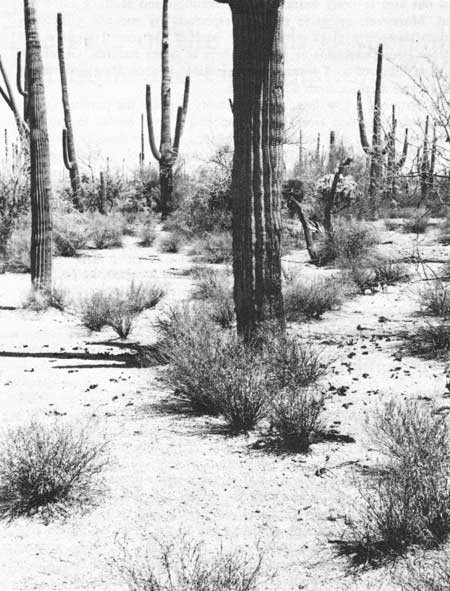|
SAGUARO
Ecology of the Saguaro: II NPS Scientific Monograph No. 8 |

|
CHAPTER 3:
THE FATE OF THE SEED: DISPERSAL, ATTRITION, AND GERMINATION
Immediately, the enormous crop of fruit is set upon by birds, rodents, and coyotes, as well as by the Indians of the area. Almost every fruit that falls is soon divested of its pulp and seeds. Probably not more than one seed in 10,000 ever germinates.—Forrest Shreve, "The saguaro, cactus camel of Arizona," 1945:696.
Seed Dispersal
Saguaro seeds reach the ground in many ways. Some fall to the soil surface while they are still in the flesh of ripe, open fruits and in dried receptacles.
Relatively heavy seedfalls occur during summer rainstorms. Rains soften and dislodge seeds from ripe fruits and dried receptacles remaining on the plant as well as from those that become lodged in the branches of associated trees and shrubs, and those already on the ground.
Summer rains aid importantly in transporting saguaro seeds to protected downslope sites affording both concealment from predators and favorable conditions for germination. After rains, seeds are found in the first few millimeters of the soil, in sand and gravel, under rock and in litter (usually mud-spattered), and nearly all are invisible to the naked eye. Natural germination occurs in such protected physical situations (Steenbergh and Lowe 1969).
Animals play a primary role in dispersal and the transport of seeds to sites suitable for germination and seedling establishment. Most fruits drop to the ground, resulting in a high concentration of seeds at the base of the parent plant and providing an attractive supply of food for mammals, birds, and insects (Figs. 18A and 18B). The congregation of herbivorous predators1 not only results in low probabilities for seed survival but also severely limits seed germination and seedling establishment. Moreover, intensive digging, especially by rodents, effectively reduces protective plant cover at the base of the parent saguaro and destroys young saguaros or exposes them to other hazards. Generally, the probability of seed survival, germination, and seedling survival in creases with distance from adult plants.
1For lack of more appropriate terms we use the words "predator" and "predation" as broadly defined to include consumption and destruction of seeds and/or plants by animals.

|
|
Fig. 18A. Typical accumulation of ripe
fruits beneath mature saguaros in flat habitats at the west Monument.
On 9 July, with six ripe fruits remaining on the plant, 179.5 g (6.3
oz)—approximately 131 thousand seeds—were recovered from
detached seed masses and 52 fruit receptacles surrounding the base of
this 3-branched, 9-m (29.5 ft) tall saguaro. Relatively low density populations of harvester ants (Pogonomyrmex sp.) and Harris' antelope ground squirrels (Citellus harrisi harrisi) are present, and round-tailed ground squirrels (Spermophilus tereticaudus) do not occur at this location. In the absence of heavy predation, a relatively large proportion of the annual seed crop remains on the ground until the occurrence of germinating rains (compare with Fig. 18B). |

|
|
Fig. 18B. Typical absence of fruit at
the base of mature saguaros in flat habitats at the east monument
(compare with Fig. 18A). Detached seed masses are absent and not seeds
are present in 45 receptacles remaining on the ground beneath this
vigorous 5-branched, 11-m (36.1-ft) tall plant. One ripe fruit still
remains on the plant. Relatively dense populations of harvester ants (Pogonomyrmex sp.) and round-tailed ground squirrels (Spermophilus tereticaudus) consume most of the seeds within a few hours after the fruits drop to the ground. In this habitat, the area surrounding the base of an adult saguaro provides little or no protection—either for seeds or seedlings—from the intensive foraging of mammals, birds, and insects. Photographed 19 July 1971. |
In a matter of a few days, animal activity beneath the parent saguaro changes the situation from one resembling a fruit basket to the seed shadow associated with some tropical plant species as described by Janzen (1970) and Krebs (1972:520). This explains why young saguaros are seldom found beneath the seed-producing parent plant. Those few seedlings that begin their establishment there do not survive the continuing heavy animal traffic at such stations.
In addition to providing an important mechanism for seed dispersal, birds frequently deposit seeds in protected locations provided by trees and shrubs away from areas of intensive animal foraging at the base of fruiting plants. Such protected locations not only increase the probability of seed survival, they generally offer more suitable conditions for seed germination and seedling establishment.
| <<< Previous | <<< Contents >>> | Next >>> |
chap3.htm
Last Updated: 21-Oct-2005